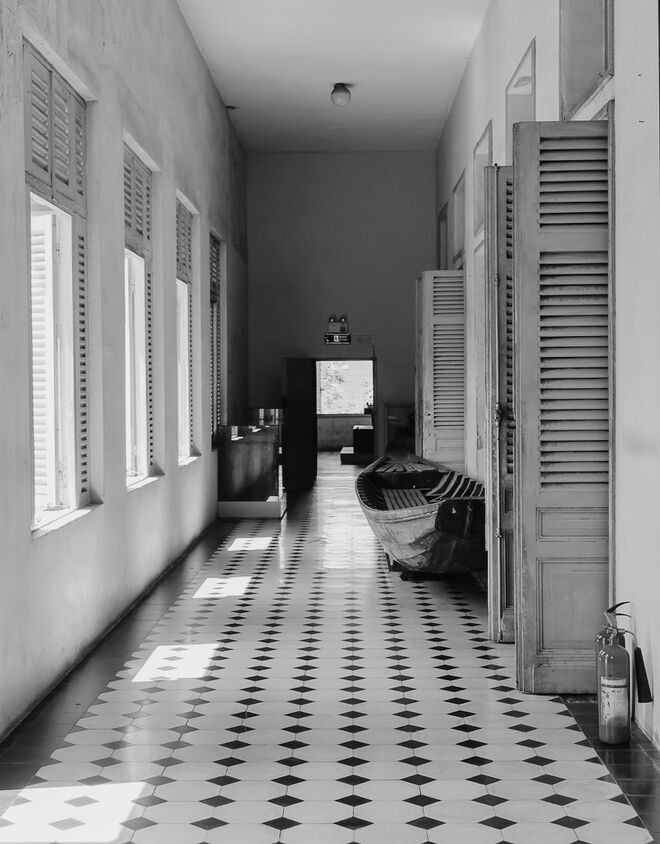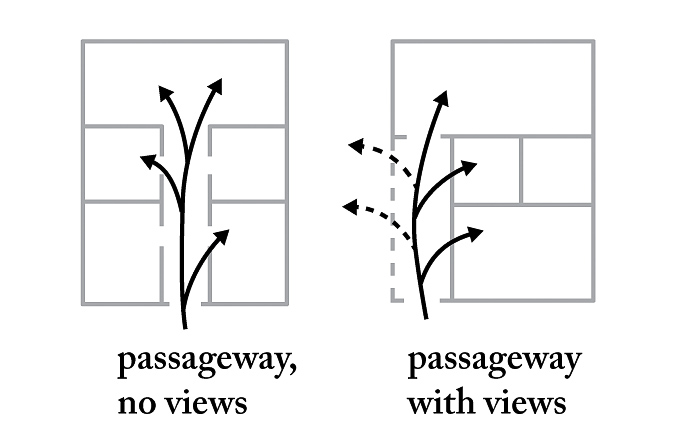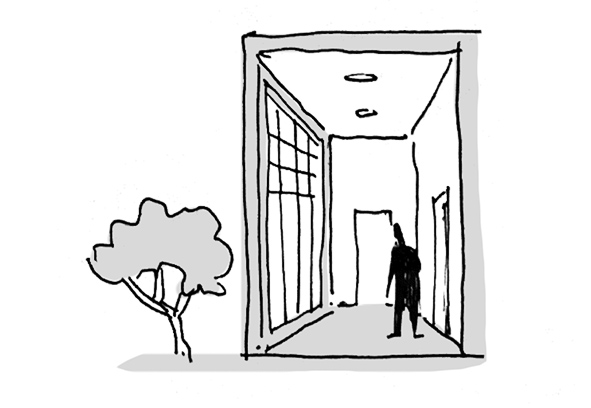10.4. Passageway View
Aus Pattern Language Wiki
(Weitergeleitet von .../Passageway View)
Within your building’s Circulation Network, be careful about the placement of passages.
Problem-statement: People tend to assume that in walking from room to room, we are focused on the utilitarian goal of moving, while we only care about a view when we arrive in a room. This is exactly backwards.
Discussion: In fact, when we occupy a room, we are often engaged with tasks that distract us from views: talking to others, reading a computer screen or printed material. It is when we are moving that we are most aware of our surroundings, and most affected by the views they offer.
In practical terms, this means that the common pattern of a dark central hallway feeding a chain of rooms on each side — known as a “double-loaded corridor” — is a terrible pattern, cutting us off from experience of the outside world, and the rest of the building. A better pattern is to wrap passageways along the exterior walls for at least part of their length, and to cluster rooms in a more complex configuration.
The field of graph theory, from mathematics, gives us some insight on this issue. In graph theory, both the nodes and the connections are equally important. In functional terms, connections such as paths are equally as important as destinations that are stationary nodes. In terms of architectural cognition, our vision of spaces changes as we move through it, forming what have been termed “isovists.”1 Previous generations of design tended to focus only on static nodes and to neglect the dynamic connections and the experience of the shape of space as people move between them. We need to pay attention to this crucial aspect of space and movement once again, by designing these transitions with equal care towards the experience and wellbeing of the user.
Therefore:
Do not make long, dark passageways that offer no views to the exterior. Instead, connect at least part of each passageway to the exterior, offering views from windows.
Use Framing to connect passageways to the outside, and to other parts of the building. Provide Human-Scale Detail and Local Symmetry to create geometric richness and complexity…
¹ Graph theory and the concept of “isovists” have been applied to understanding architectural space and movement experience by a number of investigators, notably Bill Hillier and Michael Batty, both of University College London. See for example Batty, M. (2001). Exploring isovist fields: Space and shape in architectural and urban morphology. Environment and Planning B: Planning and Design, 28(1), 123-150.
Mehaffy, M. et al. (2020). PASSAGEWAY VIEW (pattern). In A New Pattern Language for Growing Regions. The Dalles: Sustasis Press. Available at https://pattern-language.wiki/.../Passageway_View
SECTION I:
PATTERNS OF SCALE
1. REGIONAL PATTERNS
Define the large-scale spatial organization…
1.4. 400M THROUGH STREET NETWORK
2. URBAN PATTERNS
Establish essential urban characteristics…
3. STREET PATTERNS
Identify and allocate street types…
4. NEIGHBORHOOD PATTERNS
Define neighborhood-scale elements…
5. SPECIAL USE PATTERNS
Integrate unique urban elements with care…
6. PUBLIC SPACE PATTERNS
Establish the character of the crucial public realm…
7. BLOCK AND PLOT PATTERNS
Lay out the detailed structure of property lines…
8. STREETSCAPE PATTERNS
Configure the street as a welcoming place…
9. BUILDING PATTERNS
Lay out appropriate urban buildings…
10. BUILDING EDGE PATTERNS
Create interior and exterior connectivity…
10.1. INDOOR-OUTDOOR AMBIGUITY
SECTION II:
PATTERNS OF MULTIPLE SCALE
11. GEOMETRIC PATTERNS
Build in coherent geometries at all scales…
11.2. SMALL GROUPS OF ELEMENTS
12. AFFORDANCE PATTERNS
Build in user capacity to shape the environment…
13. RETROFIT PATTERNS
Revitalize and improve existing urban assets …
14. INFORMAL GROWTH PATTERNS
Accommodate “bottom-up” urban growth…
15. CONSTRUCTION PATTERNS
Use the building process to enrich the result…
SECTION III:
PATTERNS OF PROCESS
16. IMPLEMENTATION TOOL PATTERNS
Use tools to achieve successful results…
16.2. ENTITLEMENT STREAMLINING
16.3. NEIGHBORHOOD PLANNING CENTER
17. PROJECT ECONOMICS PATTERNS
Create flows of money that support urban quality…
17.4. ECONOMIES OF PLACE AND DIFFERENTIATION
18. PLACE GOVERNANCE PATTERNS
Processes for making and managing places…
18.3. PUBLIC-PRIVATE PLACE MANAGEMENT
19. AFFORDABILITY PATTERNS
Build in affordability for all incomes…
19.1. INTEGRATED AFFORDABILITY
20. NEW TECHNOLOGY PATTERNS
Integrate new systems without damaging old ones…
20.2. RESPONSIVE TRANSPORTATION NETWORK COMPANY


